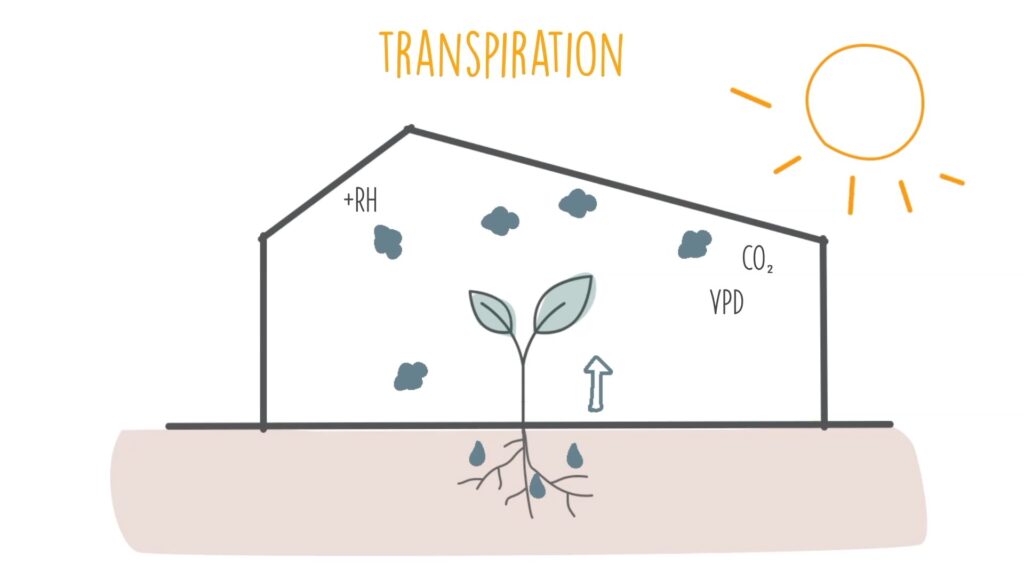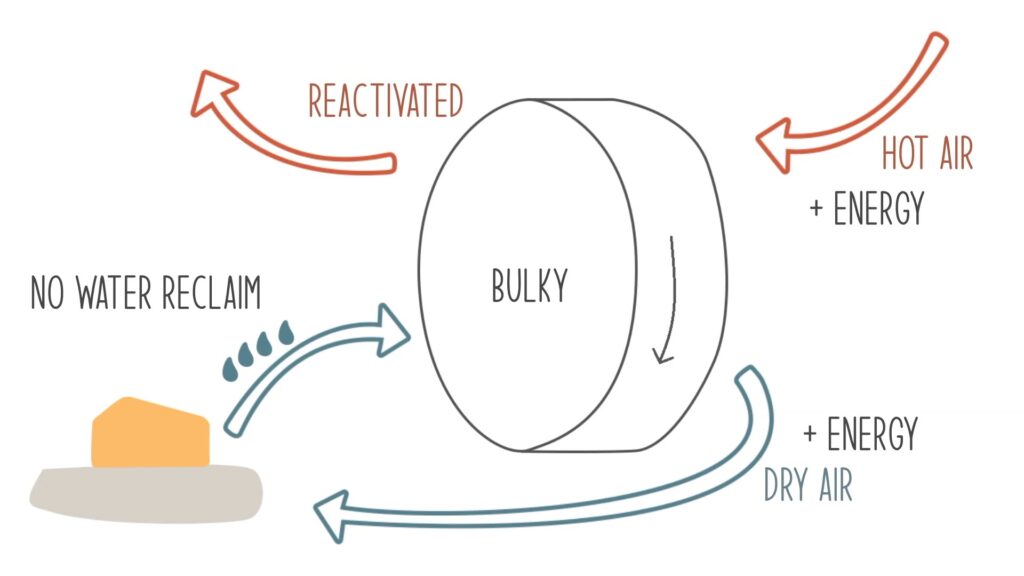In this blog we will discuss greenhouse dehumidification and different dehumidification methods that commercial growers can utilize for their vented or sealed greenhouse space to maintain a healthy and successful grow operation. Before we jump in to discussing dehumidification, let’s first make sure we have a basic understanding of plant transpiration.
What is transpiration?
If you didn’t know, plants transpire. Transpiration is the process by which plants intake water through the root system in a liquid form and exhaust it from their stomata in vapor form. This process increases the amount of moisture in the greenhouse and its relative humidity.
 Usually, transpiration is driven by environmental factors such as light intensity, carbon dioxide concentration and Vapor Pressure Deficit.
Usually, transpiration is driven by environmental factors such as light intensity, carbon dioxide concentration and Vapor Pressure Deficit.
Vapor Pressure Deficit (also called VPD) is used to describe the combination of temperature and relative humidity of the air surrounding the plant leaves. In a greenhouse, plants are exposed to a lot of light, which is also energy for plant photosynthesis. The more energy the plants receive, the more energy they need to release in order to stay healthy – and this is done through transpiration.
A healthy crop transpires a lot so there will always be some humidity to deal with. If your greenhouse is ventilated, the cheapest way to deal with this added moisture is to exhaust it outside.
It gets a little more complicated with a sealed greenhouse like the Ceres SunChamber™, which doesn’t exhaust the air but instead relies on a geothermal HVACD system to recirculate and treat the air. Typically in sealed greenhouse environments, there are two methods of dehumidification: using refrigerant – (also called condensing) and desiccant.
Before we get into refrigerant dehumidification, let’s introduce the concept of condensation.
What is condensation?
When warm and moist air gets in contact with cold surfaces, the water vapor in the air condensates. A common example of this phenomenon is the dew you can see at dawn on grass or plants after a clear sky night.
Clear sky nights make ground surfaces emit more energy because the ground gets colder on clear sky nights than on cloudy nights. On cloudy nights the ground loses less energy since the difference of temperature is smaller. As air gets colder it can hold less moisture. The temperature at which it cannot hold any more moisture is the saturation point or Dew point.

Refrigerant dehumidification for sealed grow facilities
Refrigerant or condensing dehumidification uses the same principle as the refrigeration cycle – which we covered in this video about the EcoLoop™ HVACD system.
To summarize the video, when cooling is required, the warm air from the greenhouse goes through a condenser coil which is filled with a liquid called refrigerant. The heat transfers from the warm air to the cold refrigerant. The air being cooled can then be introduced into the grow environment until the desired temperature is reached.
How does condensation apply to dehumidification?
The same process can be applied to dehumidification. In a grow environment, the excessive moisture introduced by plants’ transpiration is contained as water vapor in the air. The same air is then sucked into the HVACD system. When the moist air makes contact with the refrigerant cooling coil and reaches its dew point, condensation occurs. This is how dehumidification happens. Condensate water is considered clean and can be reclaimed. However, it is not advised to reuse this water directly into your solution unless it has been treated.

It is challenging to find efficient equipment to deal with dehumidification. One reason being that to be able to condensate as much as possible, the air has to slowly come in contact with the condenser coil. The second reason is that bringing the air to the dew point means that you have very cold air being blown into the grow environment. This cold air needs to be reheated before being reintroduced, otherwise it will stress the plants.
Throughout the dehumidification process, air is cooled down to a very low temperature, which requires a lot of energy, and then it’s heated back which requires even more energy. Dehumidification is a very energy hungry process.
The EcoLoop™ is a smart dehumidification system since it uses refrigerant dehumidification combined with efficient design of the cooling coils so it reuses some of the heat loss from the compressor. It also allows for a very high reclaim percentage of the water being transpired from the plants – up to 95%.
To learn more about the EcoLoop™ and the benefits of growing in a sealed system, check out our blog, Introducing the EcoLoop™: Ceres Most Energy-Efficient Heating and Cooling System Yet.
Desiccant dehumidification in a sealed greenhouse structure
Do you have a cat? Is it inside? Does it use a litter box? When we talk about desiccant dehumidification imagine a giant wheel filled with cat litter.
The humid air that we want to dry is blown against this wheel that emits dry air, which needs to be ducted back into the environment. The wheel keeps on rotating and after taking the moisture out of the air, the part of the wheel that gets wet needs to be reactivated. In other words, the litter needs to be dried. To achieve this, hot air is blown through the wheel producing a very warm and wet airstream that is usually rejected outside of the building. The desiccant is now “reactivated”and it is ready to absorb some of the moisture from the grow space again.

So now, we are in the opposite scenario of the condensing dehumidifier. We need an additional heating process to regenerate the “litter”, which requires energy, and then a cooling process in order to reinject the dry air to the grow environment, which also requires energy.
There are a few downsides to the desiccant system. The major one is that it is impossible to reclaim the water taken out from plant transpiration in your grow environment. Some desiccant systems place a condensing coil at the end of the wet air stream to reclaim some of the water but conventionally the wet air is simply rejected. The other downside is that it’s very heavy and bulky so it is usually not suitable for small spaces.
We hope this blog was helpful to understand the basics of dehumidification. The most simple way to dehumidify a space is by venting, but when you have a sealed greenhouse space, you must consider more involved methods like refrigerant or desiccant dehumidification. Remember that growing healthy plants means dealing with their transpiration. If you have any questions, or wish to speak to a greenhouse expert, contact us today!